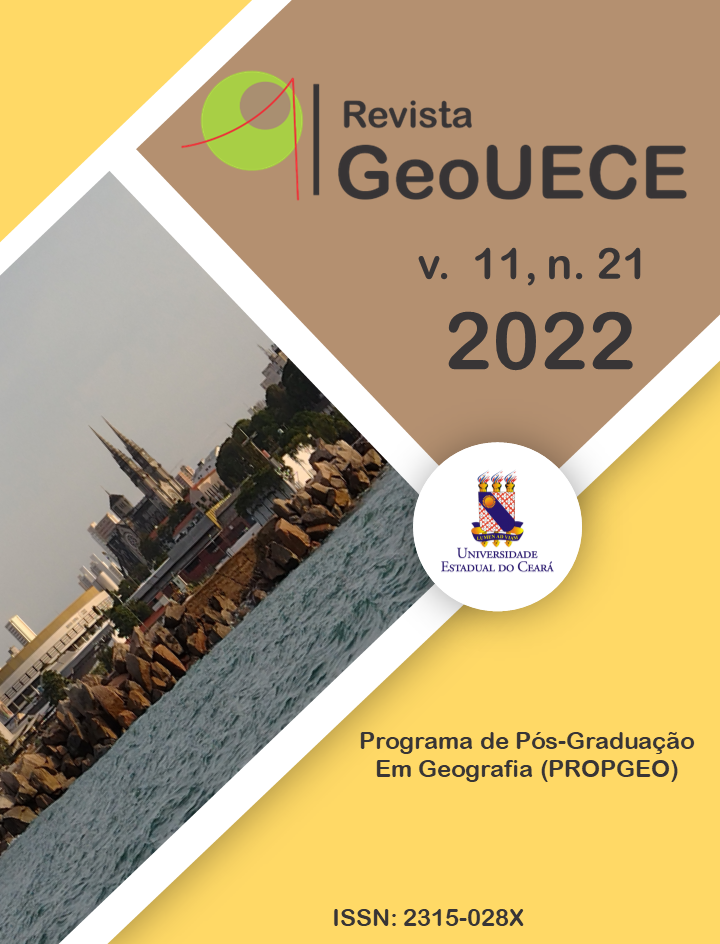The representation of the city in textbooks:
an analysis of the content of the 4th grade of elementary school
DOI:
https://doi.org/10.59040/GEOUECE.2317-028X.v11.n21.e202203Keywords:
Geografia, Processo ensino-aprendizagem, Livro Didático, CidadeAbstract
The approach to Geography in basic education requires some practices that aim to help the student understand the different aspects of the subject, through the reality of the world that surrounds them. In this article, we have tried to critically analyze how the concept of city is approached in the Geography textbook for Primary School I(Aprender Juntos - 4° ano) and how the textbook constitutes important material in the teaching-learning process. Throughout the research we sought to understand how the construction of a concept can help students develop a critical view of their reality. It was analyzed and discussed about the concept of city from a scientific perspective for classic authors of geography and finally it was investigated how this concept was approached in a specific textbook. The methodology considered: a) Readings of specific literature regarding the teaching of Geography, Urban Geography, and the concept of city; b) recognition of the textbooks for Elementary School I and choice of a material and year/teaching stage based on the approach of the analyzed content; c) exploratory analysis of the textbook, its contents, approaches, resources, and activity proposals; d) finally, the connectivity of the textbook approach with the academic literature. As a result, it was observed that there are gaps in the approach evidenced in the textbook, and that it is necessary for the teacher, as a knowledge mediator in the classroom, to add new tools, practices, and teaching methods to effectively discuss certain geographic concepts, such as the city and the urban, in the short term of two semesters.
Downloads
Metrics
References
BERNARDELLI, M. L. F. da H. Contribuição ao debate sobre o urbano e o rural. In: SPOSITO, M. E. B..; WHITACKHER, A. M. (Org.). Cidade e campo: relações e contradições entre urbano e rural. São Paulo: Expressão popular, 2006. p. 33-52.
BRASIL. Ministério da Educação. Base Nacional Comum Curricular. Brasília, 2018.
CARLOS, Ana Fani A. A urbanização da sociedade: questões para o debate. 2008, Anais. Rio de Janeiro: Lamparina, 2008. DOI: https://doi.org/10.36661/2448-1092.2008v5n8.12294
CARVALHO, Rosita Edler. Temas em educação especial. Rio de Janeiro: WVA, 1998. Disponível em:
< https://pt.scribd.com/document/423285062/Temas-Em-Educacao-Especial-Rosita-Edler-Carvalho > Acesso em: 28/08/2022.
CASTROGIOVANNI, A. C.; Goulart, L. B. A questão do livro didático em geografia elementos para uma análise. Boletim Gaúcho de Geografia, Porto Alegre, v. 16, n., p. 17-20, 1998.
CAVALCANTTI, S.L. Geografia, escola e construção de conhecimentos. Campinas, São Paulo: Papirus, p.26,1998.
GONÇALVES, Amanda Regina; MELATTI, Cláudia. Instrumentos de Análise e escolha do livro didático de geografia pelo professor: aspectos da formação cidadã. In: TONINI, Ivane Maria et al (Orgs.). O Livro didático de Geografia e os desafios da docência para aprendizagem. Porto Alegre: Sulina, 2017.
LENCIONI, S. OBSERVAÇÕES SOBRE O CONCEITO DE CIDADE E URBANO. GEOUSP Espaço e Tempo (Online), [S. l.], v. 12, n. 1, p. 109-123, 2008. DOI: https://doi.org/10.11606/issn.2179-0892.geousp.2008.74098
OLIVEIRA, P, S. F; LOPES, D, C; SOUSA, L. M. A cidade e o urbano no ensino de geografia: considerações a partir da abordagem conceitual nos Parâmetros Curriculares Nacionais – PCNs. Docplayer. Disponível em: < https://docplayer.com.br/52297482-A-cidade-e-o-urbano-no-ensino-de-geografia-consideracoes-a-partir-da-abordagem-conceitual-nos-parametros-curriculares-nacionais-pcns.html> Acesso em:10/08/2022
RUA, J; SIMONI, J. C. Repensando as relações urbano- rurais no ensino escolar: um diálogo entre professores. Geo. Uerj, Rio de Janeiro, n.37, e55279, 2020. DOI: https://doi.org/10.12957/geouerj.2020.55729
SANTOS, Milton. Técnica, Espaço, Tempo. São Paulo, Hucitec, 1994.
SILVA, L.L. Aprender Juntos geografia, 4° ano: ensino fundamental, 6.ed. São Paulo: Edições SM, 2017.
SJOBERG, Gideon. Origem e evolução das cidades. In: Cidades: a urbanização da humanidade. 2 ed. Rio de Janeiro: Zahar, 1972. Tradução de J. Reznik.
SOBARZO, O. Contribuição ao debate sobre o urbano e o rural. In: SPOSITO, M. E. B..; WHITACKHER, A. M. (Org.). O urbano e o rural em Henri Lefebvre. São Paulo: Expressão popular, 2006. P. 53-64
TAVARES, D. A.; CUNHA, J, C. O livro didático e o ensino de geografia algumas reflexões. In: V Colóquio Internacional “Educação e contemporaneidade”. São Cristóvão, SE. 2011. Disponível em: < http://educonse.com.br/2011/cdroom/eixo%205/PDF/Microsoft%20Word%20-%20O%20LIVRO%20DIDaTICO%20E%20O%20ENSINO%20DE%20GEOGRAFIA.pdf >. Acesso em: 29/09/2022.
VASCONCELOS, P. de A. A cidade, o urbano, o lugar. GEOUSP Espaço e Tempo (Online), [S. l.], v. 3, n. 2, p. 11 -15, 2006. DOI: https://doi.org/10.11606/issn.2179-0892.geousp.1999.123359
JÓFILI, Zélia. Piaget, Vygotsky, Freire e a construção do conhecimento na escola. Educação: Teorias e práticas, n.2, 1991-208, 2002.
Downloads
Published
How to Cite
Issue
Section
License
Copyright (c) 2022 Mariana Fortunato Inácio da Silva, Marcos Antônio Silvestre Gomes

This work is licensed under a Creative Commons Attribution-NonCommercial-NoDerivatives 4.0 International License.

































